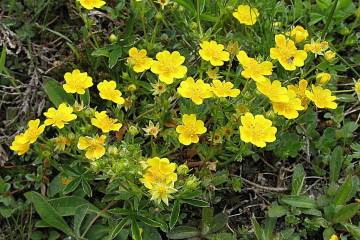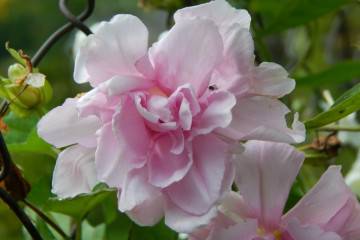Cinquefoil Goldfinger - description, planting and care
Content:
Shrub cinquefoil invariably attracts the attention of gardeners. This beauty is also called Kuril tea, five-leaf (five-leafed), and in Latin - Potentilla fruticosa. The culture has almost 500 species, differing in the size of the bush and the color of the petals.
Description Potentilla Goldfinger
Cinquefoil shrub Goldfinger is a beautiful ornamental shrub up to a meter high. The dense crown of an adult plant resembles a pillow. Shoots are straight, thin. Lanceolate leaves are bright green. The main decoration of the bush are numerous sunny yellow flowers with a simple structure. They are large in this variety, 4-5 cm in diameter. The fruit consists of many achenes.
Planting a plant
Before any planting, the soil should be properly prepared. The plot is selected sunny with fertile soil and a pH level of 7-8.5. The soil is preliminarily prepared - they dig it up, remove all weeds and level it with a rake.
Planting from seeds
Seeds of Potentilla shrub Goldfinger begin to be harvested at the end of summer. You can plant them before winter so that they undergo natural stratification.
The seeds of the culture are small, so they are:
- Scattered over the surface.
- Sprinkle with a thin layer of earth.
- Water abundantly.
Seedlings will appear in 20 days.
Goldfinger's cinquefoil grows by self-seeding. The shrub will bloom in 2 years.
Planting seedlings in open ground
Growing seedlings will allow you to get a high percentage of planting material. Seeds are sown in March. After the appearance of real leaves, the seedlings dive into separate cups. In open ground, planting is carried out at the end of summer, choosing well-developed plants.
The first two years, seedlings grow in a school. The distance between them is 30 cm. Young plants are covered for the winter.
How to care for Goldfinger Potentilla
Shrub cinquefoil does not belong to capricious plants. Caring for her consists in observing several rules.
Watering
Shrub cinquefoil is demanding on moisture and loves abundant watering, especially in dry weather. On average, each bush has 10-15 liters of water. This rate is enough for 2 waterings per month. More often only young specimens are watered.
So that the soil does not dry out quickly, it is covered with a mulching layer.
The Goldfinger Potentilla will be able to survive the dry period, but it will negatively affect the appearance and flowering of the bush.
Top dressing
Like all cultivated plants, Goldfinger shrubs require feeding. Special fertilizers for Potentilla are not produced, but complexes for ornamental plants are suitable:
- at the beginning of the growing season, the bush is fed with mineral fertilizers;
- fertilizers with potassium and phosphorus are suitable before flowering;
- mineral fertilizers are applied by autumn.
Pruning
Cardinal pruning of the bush is carried out every 3-5 years.The branches are shortened by a third, if necessary by half. It is important to achieve the same length of all shoots to give the correct ball or cube shape. Broken and dry branches are cut out completely.
Forming is carried out in April or September. The plant tolerates haircut well, which stimulates abundant flowering.
Damaged shoots and dried flowers should be removed during the season.
Reproduction methods
In addition to seed propagation, there are several other ways to get new plants.
Layers
The method is often used by gardeners due to its simple technology. The selected shoot is incised and bent to the ground. Fix it with a hairpin in the place of the incision, sprinkle it with soil. After the cutter has its own root system, it is separated from the bush and determined to a permanent place.
Cuttings
Cuttings start in June. Twigs are cut from last year's shoots. For better rooting, remove the lower leaves. Next, you should treat the cuttings with a rooting stimulant. Cuttings are planted in a shaded area, regularly spraying them with water.
Dividing the bush
For this breeding method, choose a bush older than 4 years. The division is carried out in spring or autumn in warm weather.
A shoot with growth buds is selected from the edge of the bush, disconnected and planted immediately in a permanent place.
Transfer
Prepared two-year-old seedlings are buried in pits at least 50 cm deep.
Shrub cinquefoil does not like stagnant moisture, so the planting site is drained with pebbles, gravel, broken brick with a layer of 20 cm. A layer of earth is poured on top, to which sand and humus are added.
With acidic soil, the indicator must be brought back to normal.
The seedling is set in a hole and covered with earth, adding mineral fertilizer there. The root collar is not buried; it should be at ground level.
After transplanting, the seedling is watered and sprinkled around with mulch.
For group planting, the distance between the plants is maintained at 60-80 cm.
Diseases and pests
In the description of Potentilla Goldfinger, attention is drawn to the fact of the exceptional resistance of the variety to diseases and pests. If you carry out preventive work, then the plant will not hurt, and pests do not like it at all and bypass it.
Sometimes the five-leafed scoop is annoyed by scoops, which are disposed of with the help of insecticides.
In wet and cold summers, rust can appear on the leaves. This fungal disease manifests itself in the form of rounded yellow-brown spots, which sometimes touch the stem. Rust causes the perennial green mass to dry out. To combat it, use a fungicide treatment, a 1% solution of Bordeaux liquid.
Flowering period
Cinquefoil Goldfinger blooms from June to late autumn, sometimes snow covers it blooming. The abundant and long-lasting flowering of an unpretentious culture gives it an advantage over the capricious beauties in garden design.
Preparing for winter
Cinquefoil does not require much effort in preparation for winter. With proper care, it only becomes more resistant to frost over the years and easily tolerates low temperatures.
The main danger lies not in low temperatures, but in prolonged thaws that can awaken dormant buds. New frosts can destroy awakened buds and young shoots. To avoid such a situation, before the establishment of a snow cover, the soil under the bushes, especially young ones, is mulched with a thick layer.
Use in landscape design
Goldfinger cinquefoil will decorate any corner of the garden.The cushion-shaped crown and bright yellow flowers add an accent to the composition of any area.
There are many options for placing a perennial shrub:
- hedge or curb framing;
- flower garden;
- group boarding;
- alpine slide;
- solitary plant.
Beneficial features
In the old days, healers called Kuril tea a mighty man for its healing properties. Since ancient times, the inhabitants of Siberia drank a drink made from fresh or dried leaves of Potentilla, which was brewed like tea. It tastes good, with sourness. Potentilla tea supports immunity and improves the functioning of the cardiovascular system.
Shrub cinquefoil has a lot of positive qualities: duration of flowering, longevity (up to 20 years), winter hardiness. And most importantly, it makes an excellent tonic tea. That is why it is worth getting to know this culture better and planting it in your garden.



















